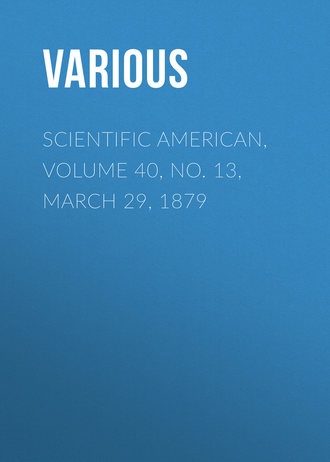 полная версия
полная версияScientific American, Volume 40, No. 13, March 29, 1879
PETER COOPER AS AN INVENTOR
The successes of Peter Cooper's long and useful life are well known. Not so many are aware of his varied experience in the direction of failure, particularly in the field of invention. More than once he has found his best devices profitless because ahead of his time, or because of conditions, political or otherwise, which no one could foresee. He possessed the rare qualities, however, of pluck and perseverance, and when one thing failed he lost no time in trying something else. Before he was of age he had learned three trades—and he did not make his fortune at either.
In a familiar conversation with a Herald writer recently, Mr. Cooper related some of his early experiences, particularly with reference to enterprises which did not succeed. His father was a hatter, and as a boy young Cooper learned how to make a hat in all its parts. The father was not successful in business, and the hatter's trade seems to have offered little encouragement to the son. Accordingly he learned the art of making ale. Why he did not stick to that calling and become a millionaire brewer, Mr. Cooper does not say. Most probably the national taste for stronger tipple could not at that time be overcome, and ale could not compete with New England rum and apple-jack. The young mechanic next essayed the art of coachmaking, at which he served a full apprenticeship. At the end of his time his employer offered to set him up in business, but the offer was not accepted, through fear of losing another's money. He felt that if he took the money and lost it he would have to be a slave for life. So he quit coachmaking and went to work for a man at Hempstead, L. I., making machines for shearing cloth. In three years, on $1.50 a day, Cooper had saved enough money to buy his employer's patent. Immediately he introduced improvements in the manufacture and in the machine, which the war with England made a great demand for by excluding foreign cloths. At this time Cooper married. In due time the family numbered three, and the young father's inventive faculty was again called upon.
"In those days," said Mr. Cooper to the reporter, smiling as the remembrance came to his mind, "we kept no servants as they do nowadays, and my wife and myself had to do all that was to be done. After our first child was born I used to come into the house and find my wife rocking the cradle, and I relieved her from that while I was there. After doing that for a few days I thought to myself that I could make that thing go of itself. So I went into my shop, and made a pendulous cradle that would rock the child. Then I attached a musical instrument which would sing for it, and at the same time the machine would keep the flies off. The latter was very simple; by hanging something to the cross bar, as the cradle swung under it, backward and forward, it would create wind enough to drive away the flies. The machine was wound up by a weight, and would run for nearly half an hour without stopping. I took out a patent for it, and one day a peddler came along with a horse and wagon, as they do in the country, and saw the cradle. He struck a bargain with me and bought the patent right for the State of Connecticut, giving for it his horse and wagon and all the goods he had with him. They afterward made some there, but nothing like as good as mine. It was a beautiful piece of furniture," said Mr. Cooper regretfully, as he thought of it as a thing of the past. "They afterward substituted springs for the weight movement, but that kind was not so good."
About this time the war with England ended and the market was spoiled for the shearing machines. Then, we believe, Mr. Cooper tried his hand at cabinetmaking, but that failed, and he set up a grocery store where the Bible House now stands. While selling groceries Mr. Cooper made an invention which ought to have made his fortune, but it did not. The story is best told in Mr. Cooper's own words:
"It was just before the Erie Canal was completed, and I conceived a plan by which to tow boats by the use of all the elevated waters on the line of the canal. To demonstrate that that was practicable I made with my own hands a chain two miles long, and placed posts 200 feet apart in the East River from Bellevue dock down town about a mile. These posts supported grooved wheels to lay the chain in, forming an endless chain. The whole was moved by an overshot waterwheel placed at the Bellevue dock. A reservoir twelve feet square and three deep held the water to turn the wheel."
At the suggestion of Governor Clinton Mr. Cooper tightened his chain and pulled up the end post just before the grand trial of his device was to come off. He succeeded in getting stone enough to anchor the post, however, and the experiment went off swimmingly. The boat was hooked on to the chain, and the passage back and forward—two miles—was made in eleven minutes.
"I ran that boat some ten days," says Mr. Cooper, "to let people see what could be done, and carried nearly a thousand people. Part of the time I ran two boats. Once I counted 52 people in one boat. I made the whole chain myself and planted the posts. As I could find no wheels to suit me I made the moulds and cast the wheels myself out of block tin and zinc. It was no small job, I can tell you."
This was unquestionably a grand invention. In itself it was a perfect success; but it was not used. Mr. Cooper tells why:
"It demonstrated completely that the elevated water power along the line of the canal and every lock in the canal could be made use of to drive the boats. Governor Clinton gave me $800 for the privilege of buying the right to the plan in case he should want to use it on the Erie Canal. In making the canal he had promised the people along the route that as soon as it was finished they could sell their horses to tow the boats, their grain and fodder to feed the horses, and their provisions for the passengers. On reflection he thought that if he took all that away from them he would have to run the gantlet again, and he could not afford to do that. There never was anything done with the plan until a few years ago, when Mr. Welch, president of the Camden and Amboy Railroad and Canal, invented exactly the same thing and put it in practice on his locks on the canal. He found it saved half the time and great expense. He went to Washington to take out a patent for it, and when he got there he found that I had patented the same thing fifty-three years before. My patent had run out, so he could use the plan on his canal. It has also been used on one lock on the Erie Canal. If they could have used that chain on the whole length of the Erie Canal it would have saved many millions of dollars."
This would not be a bad place, were there room for it, to speak of "undeveloped" and therefore worthless inventions; and the assumption that if an inventor does not make his invention immediately profitable it must be good for nothing, and should be dispatented. But the moral goes without telling.
Mr. Cooper's next attempt at invention was made about the same time, but in quite a different direction. It was during the struggle of the Greeks for independence, and wishing to do something for their assistance, Mr. Cooper undertook to make a torpedo boat for them. Mr. Cooper says:
"It was a small one that could be taken on board ship and used to destroy any vessel that came to destroy them. It was fixed with a rotary steam engine and a screw wheel to propel it. It was intended to be guided from the ship or the shore. There were two steel wires fixed to the tiller of the rudder, and the operator could pull on one side or the other and guide the vessel just as a horse is guided with reins. It was so arranged that at night it would carry a light with its dark side toward the object to be destroyed, and by simply keeping the light in range with the vessel it would be sure to hit it. The torpedo was carried on a little iron rod, projecting in front of the torpedo vessel a few inches under water. Contact would discharge the torpedo and bend this iron rod. This would reverse the action of the engine and cause the torpedo vessel to return right back from whence it came, ready to carry another torpedo."
Unfortunately the torpedo boat was not ready in time to go with the ship carrying the contributions for Greece. It was stored in Mr. Cooper's factory (he had then turned his attention to glue) and was destroyed by the burning of the factory. It seems to have been quite a promising affair for the time. Mr. Cooper says:
"I experimented with it at once to see how far it could be guided. I made a steel wire ten miles long and went down to the Narrows to test the matter. I had steel yards fastened to one end of the wire, and to the other end the torpedo vessel as attached. It got about six miles away when a vessel coming into the harbor crossed the wire and broke it. Although the experiment was not complete it showed that for at least six miles I could guide the vessel as easily as I could guide a horse."
Mr. Cooper's work as the pioneer locomotive builder in this country; his later inventions and improvements in the manufacture of railway iron and wrought iron beams for fireproof buildings; his application of anthracite coal to iron puddling, and his other successes are almost as widely known as his philanthropic efforts for the education and advancement of the industrial classes of this city.
After all, we are not sure but the story of his long and varied and always honorable career, told by himself, would not be worth, to young people who have to make their way in life through many difficulties, more even than the advantages of the noble institution which bears his name.
Taste for Reading.—Sir John Herschel has declared that "if he were to pray for a taste which should stand under every variety of circumstance and be a source of happiness and cheerfulness to him through life, it would be a taste for reading." Give a man, he affirms, that taste, and the means of gratifying it, and you cannot fail of making him good and happy; for you bring him in contact with the best society in all ages, with the tenderest, the bravest, and the purest men who have adorned humanity, making him a denizen of all nations, a contemporary of all times, and giving him a practical proof that the world has been created for him, for his solace, and for his enjoyment.
Africa Crossed Again
Information has been received by way of Lisbon, March 12, that the Portuguese explorer, Pinto, has succeeded in traversing Africa from west to east, and has reached Transvaal. The latitude of his course across is not mentioned.
CURIOUS FACTS IN MAGNETISM
At the meeting of the New York Academy of Sciences February 17th, the article in the March number of Harper's Magazine, entitled "Gary's Magnetic Motor," was incidentally alluded to, and Prof. C. A. Seeley made the following remarks: The article claims that Mr. Gary has made a discovery of a neutral line or surface, at which the polarity of an induced magnet, while moving in the field of the inducing pole, is changed. The alleged discovery appears to be an exaggerated statement of some curious facts, which, although not new, are not commonly recognized. If a bar of iron be brought up, end on, near a magnetic pole, the bar becomes an induced magnet, but an induced magnet quite different from what our elementary treatises seem to predict. On the first scrutiny it is a magnet without a neutral point, and only one kind of magnetism—namely, that of the inducing pole. Moreover, the single pole is pretty evenly distributed over the whole surface, so that if iron filings be sprinkled on the bar they will be attracted at all points and completely cover it. Now, if while the bar is covered by filings it be moved away from the inducing pole, the filings will gradually and progressively fall, beginning at the end nearest the inducing pole and continuing to some point near the middle of the bar; the filings at the remote end will generally be held permanently. When the bar is carried beyond the field of the inducing pole it is simply a weak magnet of ordinary properties—i. e., of two poles and a neutral point between them.
A plausible and simple explanation of this case is that the inducing pole holds or binds the induced magnetism of opposite name, so that it has no external influence; the two magnetisms are related to each other as are the positive and negative electricities of the Leyden jar. Let the inducing pole be N.; the S. of the bar will be attracted by it and bound, while the N. of the bar becomes abnormally free and active. On moving the bar from the pole the bound magnetism is released and a part becomes residual magnetism. Now when the residual balances the free magnetism which is of opposite name, we are on Gary's neutral line. In a restricted sense there is a change of polarity over the half of the bar contiguous to the inducing pole; on the other half there is no change of pole in any sense. Experiment with a shingle nail in the place of the filings, à la Gary, bring the nail to the induced bound pole, and it may be held, except at the neutral line. Now if one will read the magazine article with such ideas as these he will feel pretty sure that the writer of it has used words recklessly, that Gary has not made an original discovery, and that the "neutral" line, whatever it be, has only an imagined relation to the "principle" of the motor.
The Gary Motor as a perpetual motion scheme, of course, is not worthy of serious notice from a society devoted to science. It has no noteworthy novelty of construction or conception. Mr. Gary is afflicted with the very old delusion of the cut-off or shield of magnetism, which is to cost less than what comes from it. His cut-off is a sheet of iron, which we know acts simply as an armature.
A New Phenomenon in Statical Electricity
M. E. Duter, in a paper read before the French Academy in December, showed that when a Leyden jar is charged with either positive or negative electricity its internal volume increases, and that this effect is a new phenomenon, unexplainable by either a theory of an increase of temperature or of an electrical pressure. The experiment was performed by means of a flask-shaped Leyden jar with a long tube attached to its neck, and containing a liquid which served as the inner armature. The author's attention had been called to the fact that this phenomenon had been observed ten years ago by M. Gori.
His researches, just made public, leave no doubt of the accuracy of M. Duter's view, that the glass of the jar really expands. According to the theory of elasticity, the effect of an internal pressure in a hollow sphere is in the inverse ratio of its thickness. M. Duter, therefore, had three flasks made of the same volume, but of thicknesses of 4 mm., 0.8 mm., and 0.5 mm. respectively. They were filled with water and enveloped by tin foil. Each carried a capillary thermometer tube, in which the variations of the height of liquid served to measure the changes in volume due to electrification. He found that these changes were imperceptible in the thick glass, very marked in the flask of mean thickness, and rose to 30 mm. in the thinnest. The variations in volume were very nearly in inverse ratio of the square roots of the thicknesses.
A NEW ORE CRUSHER
The accompanying engravings represent an improved ore crusher, which is said to be very effective and economical in the use of power.
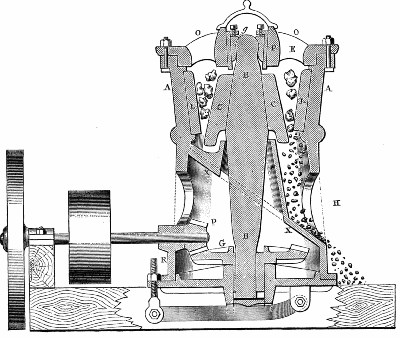
Fig. 1—BROWN'S ORE CRUSHER.
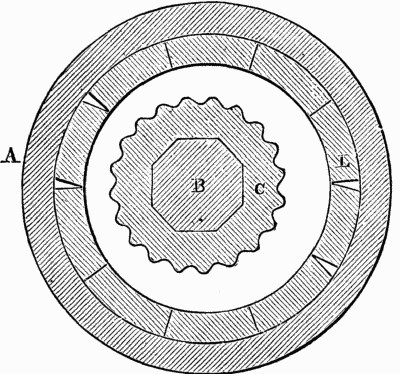
Fig. 2—HORIZONTAL SECTION.
A short vertical cast iron cylinder, A, having in one side a discharge opening, H, contains all of the movable parts.
The upper portion of the cylinder is lined with chilled iron plates, L, and an inclined chute, X, leads to the discharge opening, H.
A rigid shaft, B, carries the circular crusher, C, and moves in a ball and socket joint at the upper end, and extends eccentrically through the boss of a bevel wheel, G, at its lower end, and rests on a step supported by a lever that may be adjusted by the screw, R. The wheel, G, is driven by the pinion, P, on whose shaft there are a pulley and a fly-wheel.
The double gyratory motion of the crusher, C, causes it to approach all portions of the lining, L, crushing whatever lies between.
It is said that this machine is capable of crushing 10 tons of the hardest ore per hour. Its weight is 6,500 lbs.—Musée de l'Industrie.
RECENT AMERICAN PATENTS
Enos Richmond, of Troy, N. Y., has invented a steak tenderer, having a plunger studded with chisel-pointed rods, and arranged in a case in connection with an elevating spring. A blow upon the knob at the top of the plunger forces the chisel-pointed rods through holes in the casing into the meat, the casing resting on the surface of the steak.
Messrs. A. W. Southard and Volney R. Sears, of Falls City, Neb., have patented an improved invalid bedstead, which is provided with ingenious mechanism for placing the invalid in different positions.
An improved spring attachment for carriage tops, which is designed to prevent the rear bow from being bent by the weight of the top when turned back, has been patented by Mr. Robert E. McCormick, of Doylestown, O.
Mr. Espy Gallipher, of Schellsburg, Pa., has devised an axle journal having a groove lengthwise upon its upper side which extends back upon the surface of the axle and communicates with an oil cup. A sliding rod occupies a portion of the groove; when this rod is drawn out it permits the oil to fill the groove; when it is pushed into the groove in the axle, the oil is ejected and a further supply is cut off.
An improved pill machine, invented by Messrs. W. N. Fort and R. R. Moore, of Lewisville, Ark., is adapted to the manufacture of pills in large quantities. The machine has mechanism for grinding and mixing ingredients, a grooved wheel and trough for forming the pills, and a device for applying powder.
An improvement in millstone adjustments has been patented by Mr. Stephen P. Walling, of South Edmeston, N. Y. This invention consists in a screw applied to the end of the mill spindle on which the stone is rigidly held, so that the running stone may be forced by the screw away from the stationary stone and held against the action of a spring at the opposite end of the spindle, the object being to prevent the stones from becoming dulled by contact with each other.
An improved attachment for sewing machines for soaking or waxing the thread as it passes the needle, has been patented by Mr. Pedro F. Fernandez, of San Juan, Porto Rico. The invention consists in a frame secured to the arm of a sewing machine by a thumb-screw, and provided with a clamping device for holding wax or soap.
A novel combination of a toggle and springs and levers for operating a drag saw has been patented by Mr. Harvey Hughes, of Wheat Ridge, Ohio. The saw, while properly guided, is free to move up or down without affecting the leverage.
An improvement in filters, which consists in re-enforcing the felt disk with a backing of wire cloth to enable it to resist heavy water pressure, has been patented by Mr. B. P. Chatfield, of Aiken, S. C.
A basket having light sheet metal sides attached to a wooden bottom by crimping the edges over a rib on the periphery of the bottom, has been patented by Mr. Samuel Friend, of Decatur, Ill. The handle and lid may be easily removed to permit of packing and storage.
An improved cross bar for fastening doors, patented by Mr. Richard Condon, of La Salle, Ill., has a spring acted portion which engages a socket on the door casing, and is retained in that position by a spring catch.
A NEW IRONING TABLE
The accompanying engraving represents a convenient and inexpensive table recently patented by Mr. Albert H. Hogins, of Morrisania, N. Y. It is more especially designed for ironing, but it may be used for other purposes when closed up. The top is made in two tapering sections, A B. The section, B, is narrower than the other, and is pivoted at its wider end to a bar, E, which slides into a socket formed in the table. The table has five legs, one of which, D, is attached to a sliding rail that supports the narrower end of the movable part of the top. The table is provided with a drawer in one end and with a tray, C, for containing blankets, etc.
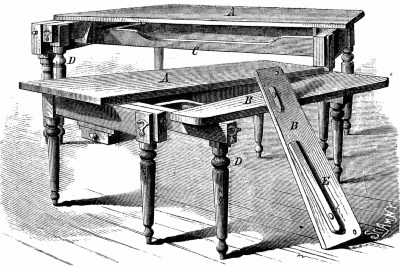
HOGINS' IMPROVED TABLE.
The convenience and practicability of this table for general laundry use, will be apparent without further explanation. The board, B, when drawn out will be used for ironing skirts, shirts, and other garments requiring a board of this character, and when the table is closed together and fastened by the hooks, it may be used in ironing larger articles. When closed it presents the appearance of an ordinary table and may be used as such.
Further information may be obtained by addressing the inventor as above.
A NOVEL ENGINE REGULATOR
The accompanying engraving represents two different styles of regulator, invented by Mr. Stenberg, in which the effect of centrifugal force is utilized. In a vessel, A, of parabolic shape is placed a disk, C, which floats on glycerine contained by the vessel, and is attached to the walls of the vessel by an annular membrane, so that it may rise and fall in a vertical direction as the glycerine is carried with more or less force toward the edge of the vessel by centrifugal action. The inner surface of the vessel, A, is provided with radial grooves, by which the rotary motion of the vessel is communicated to the glycerine. To the center of the disk, C, is attached a vertical rod, which extends downward through the hollow shaft and is connected with governor valve. An increase of speed throws the glycerine toward the periphery of the valve, and, raising the disk, C, closes the steam valve; a diminution of speed permits the glycerine to fall back, when the disk descends and the valve opens.
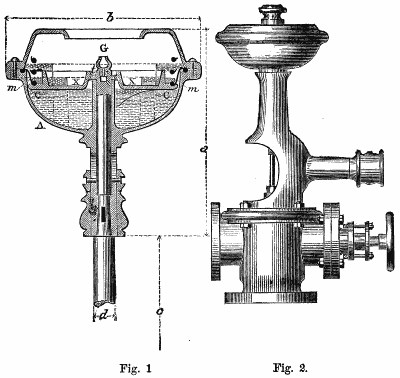
STENBERG REGULATOR.
The disk, C, has a small aperture for the admission and escape of air, and the apparatus is adjusted by pouring lead into the groove in the disk.
The regulator shown in Fig. 2 operates upon the same principle, but it is adjusted by means of a spring.
This apparatus is manufactured by Blancke Bros., Magdeburg.—Musée de l'Industrie.
A Strange People
Botel Tobago is an island in the South Seas which has lately been visited by a party of United States naval officers. They were surveying a rock east of the South Cape of Formosa, and called at this island. They found a curious race of Malay stock. These aborigines did not know what money was good for. Nor had they ever used tobacco or rum. They gave the officers goats and pigs for tin pots and brass buttons, and hung around the vessel all day in their canoes waiting for a chance to dive for something which might be thrown overboard. They wore clouts only, ate taro and yams, and had axes, spears, and knives made of common iron. Their canoes were made without nails, and were ornamented with geometrical lines. They wore the beards of goats and small shells as ornaments.
Such is the account of these strange people given by Dr. Siegfried, in a letter read at the last meeting of the Philadelphia Academy of Natural Sciences.
REMEDY FOR THE NEW CARPET BEETLE
Noticing a statement made by Mr. J. A. Lintner, to the effect that the Persian insect powder would probably prove unavailing as a remedy against the ravages of the new carpet beetle (Anthrenus), W. L. Carpenter, of the U.S.A., was led to institute some experiments with this well known insecticide, the results of which he communicates to the current number of the Naturalist. A small quantity of the powder was introduced, on the point of a penknife, under a tumbler beneath which various insects were consecutively confined. The movements of the insects brought them in contact with the poison, which readily adhered to their body; in endeavoring to remove it from their appendages a few particles would be carried to the mouth and thence to the stomach, with fatal effect. The results were briefly thus: A honey bee became helpless in 15 minutes; a mad wasp in 8 minutes; a small ant in 5 minutes; a large butterfly resisted the effects for over an hour, and apparently recovered, but died the next day; a house-fly became helpless in 10 minutes; a mosquito in 15; and a flea in 3 minutes. In experimenting on beetles, an insect was secured as nearly the size of the carpet beetle as could be found. It was easily affected, and became helpless in 12 minutes.











